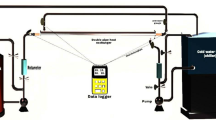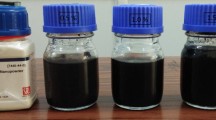In this research, the thermal performance of a cylindrical heat pipe filled with a ferrofluid as the working liquid was tested at different inclination angles: 0, 60, and 90o. The ferrofluid was synthesized from magnetite particles and water as the base fluid. The heat pipe was manufactured from a copper container, and copper fibers were used as the wick structure inside the heat pipe. The magnetite particles had an average diameter of 13 nm, as was yielded by the transmission electron microscopy (TEM). The zeta potential value (30.25 mV) and visual analysis showed that the ferrofluid was stable for nine months and could be used as the working liquid in cylindrical heat pipes. The thermal conductivity and specific heat of the ferrofluid were 0.605 W/(m·K) and 4090 J/(kg∙K), respectively. The performances of the heat pipe at different inclination angles allowed the conclusion about a relatively stable thermal resistance and temperature distribution, particularly at a higher heat input of 15 W.
Similar content being viewed by others
References
A. P. Tetuko, B. Shabani, R. Omrani, B. Paul, and J. Andrews, Study of a thermal bridging approach using heat pipes for simultaneous fuel cell cooling and metal hydride hydrogen discharge rate enhancement, J. Power Sources, 397, 177–188 (2018).
J. Smith, R. Singh, M. Hinterberger, and M. Mochizuki, Battery thermal management system for electric vehicle using heat pipes, Int. J. Therm. Sci., 134, 517–529 (2018).
A. P. Tetuko, R. K. Hadi, M. Faqih, E. A. Setiadi, C. Kurniawan, and P. Sebayang, Heat pipes as a passive cooling system for flywheel energy storage application, J. Phys. Conf. Ser., 1191, Article ID 012024 (2019).
X. Chen, H. Ye, X. Fan, T. Ren, and G. Zhang, A review of small heat pipes for electronics, Appl. Therm. Eng., 96, 1–17 (2016).
R. R. Gnanadurai and A. S. Varadarajan, Investigation on the effect of cooling of the tool using heat pipe during hard turning with minimal fluid application, Eng. Sci. Technol. Int. J., 19, 1190–1198 (2016).
T. S. Jadhav and M. M. Lele, Theoretical energy saving analysis of air conditioning system using heat pipe heat exchanger for Indian climatic zones, Eng. Sci. Technol. Int. J., 18, 669–673 (2015).
B. Zohuri, Heat Pipe Design and Technology: Modern Applications for Practical Thermal Management, Springer (2016).
D. Reay and P. Kew, Heat Pipes. Theory, Design and Applications, Elsevier, Butterworth–Heinemann (2005).
A. Faghri, Heat Pipes Science and Technology, Taylor and Francis, Washington (1995).
X. Yang, Y. Y. Yan, and D. Mullen, Recent developments of lightweight, high performance heat pipes, Appl. Therm. Eng., 33–34, 1–14 (2012).
C. W. Chan, E. Siqueiros, J. Ling-Chin, M. Royapoor, and A. P. Roskilly, Heat utilisation technologies: A critical review of heat pipes, Renew. Sustain. Energy Rev., 50, 615–627 (2015).
H. Jouhara, A. Chauhan, T. Nannou, S. Almahmoud, B. Delpech, and L. C. Wrobel, Heat pipe based systems ― Advances and applications, Energy, 128, 729–754 (2017).
J. M. Maldonado, A. de Gracia, and L. F. Cabeza, Systematic review on the use of heat pipes in latent heat thermal energy storage tanks, J. Energy Storage, 32, Article ID 101733 (2020).
G. Huang, W. Li, G. Zhong, A. A. Abdulshaheed, and C. Li, Optimizing L-shaped heat pipes with partially-hybrid mesh-groove wicking structures, Int. J. Heat Mass Transf., 170, Article ID 120926 (2021).
S. Zhang, C. Chen, G. Chen, Y. Sun, Y. Tang, and Z. Wang, Capillary performance characterization of porous sintered stainless steel powder wicks for stainless steel heat pipes, Int. Commun. Heat Mass Transf., 116, Article ID 104702 (2020).
A. S. Barrak, A. A. M. Saleh, and Z. H. Naji, An experimental study of using water, methanol, and binary fluids in oscillating heat pipe heat exchanger, Eng. Sci. Technol. Int. J., 23, 357–364 (2020).
M. Kaya, An experimental investigation on thermal efficiency of two-phase closed thermosyphon (TPCT) filled with CuO/water nanofluid, Eng. Sci. Technol. Int. J., 23, 812–820 (2020).
S. K. Das, S. U. S. Choi, W. Yu, and T. Pradeep, Nanofluids Science and Technology, John Wiley & Sons, Inc., Hoboken, New Jersey (2008).
S. Eiamsa-Ard, K. Kiatkittipong, and W. Jedsadaratanachai, Heat transfer enhancement of TiO2/water nanofluid in a heat exchanger tube equipped with overlapped dual twisted-tapes, Eng. Sci. Technol. Int. J., 18, 336–350 (2015).
S. A. Ahmed, M. Ozkaymak, A. Sözen, T. Menlik, and A. Fahed, Improving car radiator performance by using TiO2–water nanofluid, Eng. Sci. Technol. Int. J., 21, 996–1005 (2018).
N. Putra, W. N. Septiadi, H. Rahman, and R. Irwansyah, Thermal performance of screen mesh wick heat pipes with nanofluids, Exp.Therm. Fluid Sci., 40, 10–17 (2012).
L. G. Asirvatham, R. Nimmagadda, and S. Wongwises, Heat transfer performance of screen mesh wick heat pipes using silver–water nanofluid, Int. J. Heat Mass Transf., 60, 201–209 (2013).
Y. C. Chiang, W. C. Kuo, C. C. Ho, and J. J. Chieh, Experimental study on thermal performances of heat pipes for air-conditioning systems influenced by magnetic nanofluids, external fields, and microwicks, Int. J. Refrig., 43, 62–70 (2014).
K. M. Kim, Y. S. Jeong, I. G. Kim, and I. C. Bang, Comparison of thermal performance of water-filled, SiC nanofluid filled and SiC nanoparticles-coated heat pipes, Int. J. Heat Mass Transf., 88, 862–871 (2015).
M. M. Sarafraz, O. Pourmehran, B. Yang, and M. Arjomandi, Assessment of the thermal performance of a thermosyphon heat pipe using zirconia–acetone nanofluids, Renew. Energy, 136, 884–895 (2019).
M. Kole and T. K. Dey, Thermal performance of screen mesh wick heat pipes using water-based copper nanofluids, Appl. Therm. Eng., 50, 763–770 (2013).
G. Kumaresan, S. Venkatachalapathy, and L. G. Asirvatham, Experimental investigation on enhancement in thermal characteristics of sintered wick heat pipe using CuO nanofluids, Int. J. Heat Mass Transf., 72, 507–516 (2014).
E. Sadeghinezhad, M. Mehrali, M. A. Rosen, A. R. Akhiani, S. R. Latibari, M. Mehrali, and H. S. C. Metselaar, Experimental investigation of the effect of grapheme nanofluids on heat pipe thermal performance, Appl. Therm. Eng., 100, 775–787 (2016).
W. I. A. Aly, M. A. Elbalshhouny, H. M. Abd El-Hameed, and M. Fatouh, Thermal performance evaluation of a helically-micro-grooved heat pipe working with water and aqueous Al2O3 nanofluid at different inclination angles and filling ratios, Appl. Therm. Eng., 110, 1294–1304 (2017).
M. Mahdavi, S. Tiari, S. De Schampheleire, and S. Qiu, Experimental study of the thermal characteristics of a heat pipe, Exp. Therm. Fluid Sci., 93, 292–304 (2018).
M. Taslimifar, M. Mohammadi, H. Afshin, M. H. Saidi, and M. B. Shafii, Overall thermal performance of ferrofluidic open loop pulsating heat pipes: An experimental approach, Int. J. Therm. Sci., 65, 234–241 (2013).
A. Gandomkar, M. H. Saidi, M. B. Shafii, M. Vandadi, and K. Kalan, Visualization and comparative investigations of pulsating ferrofluid heat pipe, Appl. Therm. Eng., 116, 56–65 (2017).
H. M. Goshayeshi, F. Izadi, and K. Bashirnezhad, Comparison of heat transfer performance on closed pulsating heat pipe for Fe3O4 and g-Fe2O3 for achieving an empirical correlation, Phys. E: Low-Dimens. Syst. Nanostructures, 89, 43–49 (2017).
W. Kang, Y. C. Wang, Y. C. Liu, and H. M. Lo, Visualization and thermal resistance measurements for a magnetic nanofluid pulsating heat pipe, Appl. Therm. Eng., 126, 1044–1050 (2017).
A. P. Tetuko, L. F. Nurdiyansah, M. Addin, E. A. Setiadi, M. Ginting, and P. Sebayang, Magnetic nanofluids as heat transfer media in heat pipes, Adv. Nat. Sci.: Nanosci. Nanotechnol., 11, No. 2, Article ID 025002 (2020).
N. S. Asri, A. P. Tetuko, A. Esmawan, M. Addin, E. A. Setiadi, W. B. K. Putri, M. Ginting, and P. Sebayang, Syntheses of ferrofluids using polyethylene glycol (PEG) coated magnetite (Fe3O4), citric acid, and water as the working liquid in a cylindrical heat pipe, Nano-Struct. Nano-Objects, 25, Article ID 100654 (2021).
P. Kumar, H. Khanduri, S. Pathak, A. Singh, G. A. Basheed, and R. P. Pant, Temperature selectivity for single phase hydrothermal synthesis of PEG-400 coated magnetite nanoparticles, J. Chem. Soc., Dalt. Trans., 49, 8672–8683 (2020).
P. K. Das, A. K. Mallik, R. Ganguly, and A. K. Santra, Stability and thermophysical measurements of TiO2 (anatase) nanofluids with different surfactants, J. Mol. Liq., 254, 98–107 (2018).
A. Barhoum, M. L. García-Betancourt, H. Rahier, and G. Van Assche, Physicochemical characterization of nanomaterials: Polymorph, composition, wettability, and thermal stability, in: A. Barhoum and A. S. Hamdy (Eds.), Emerging Applications of Nanoparticles and Architectural Nanostructures: Current Prospects and Future Trends, Elsevier Inc. (2018), pp. 255–278.
C. J. Chirayil, J. Abraham, R. K. Mishra, S. C. George, and S. Thomas, Instrumental techniques for the characterization of nanoparticles, in: S. Thomas, R. Thomas, A. K. Zachariah, and R. K. Mishra (Eds.), Thermal and Rheological Measurement Techniques for Nanomaterials Characterization, Jaipur, India (2017), pp. 1–56.
M. Alsaadi, R. Fu, B. Li, R. Boukhanouf, and Y. Yan, Thermo-physical properties and thermo-magnetic convection of ferrofluid, Appl. Therm. Eng., 88, 14–21 (2015).
J. J. W ang, R. T. Zheng, J. W. Gao, and G. Chen, Heat conduction mechanisms in nanofluids and suspensions, Nano Today, 7, No. 2, 124–136 (2012).
A. P. Tetuko, S. Simbolon, T. G. Sitorus, R. Zurcher, R. K. Hadi, E. A. Setiadi, C. Kurniawan, M. Ginting, and P. Sebayang, The effect of magnetic nano-fluids (Fe3O4) on the heat transfer enhancement in a pipe with laminar flow, Heat Mass Transf., 56, No. 1, 65–74 (2020).
R. Senthilkumar, S. Vaidyanathan, and B. Sivaraman, Performance analysis of heat pipe using copper nanofluid with aqueous solution of n-butanol, Int. J. Mech. Math. Eng., 1, 251–256 (2010).
R. R. Riehl and N. D. Santos, Water–copper nanofluid application in an open loop pulsating heat pipe, Appl. Therm. Eng., 42, 6–10 (2011).
G. Rosengarten, A. P. Tetuko, K. K. Li, A. Wu, and R. Lamb, The effect of nano-structured surfaces on droplet impingement heat transfer, in: Proc. ASME 2011 International Mechanical Engineering Congress and Exposition, IMECE 2011, Washington (2011), pp. 1029–1036.
A. P. Tetuko, D. S. Khaerudini, P. Sardjono, P. Sebayang, and G. Rosengarten, Superhydrophobic surface as a fluid enhancement material in engineering applications, AIP Conf. Proc., 1555 (1) (2013), pp. 3–6.
Author information
Authors and Affiliations
Corresponding author
Additional information
Published in Inzhenerno-Fizicheskii Zhurnal, Vol. 96, No. 1, pp. 199–207, January–February 2023
Rights and permissions
Springer Nature or its licensor (e.g. a society or other partner) holds exclusive rights to this article under a publishing agreement with the author(s) or other rightsholder(s); author self-archiving of the accepted manuscript version of this article is solely governed by the terms of such publishing agreement and applicable law.
About this article
Cite this article
Asri, N.S., Tetuko, A.P., Ridwan, M. et al. Performances of a Cylindrical Heat Pipe Using Ferrofluid as the Working Liquid at Different Inclination Angles. J Eng Phys Thermophy 96, 197–205 (2023). https://doi.org/10.1007/s10891-023-02676-2
Received:
Published:
Issue Date:
DOI: https://doi.org/10.1007/s10891-023-02676-2




